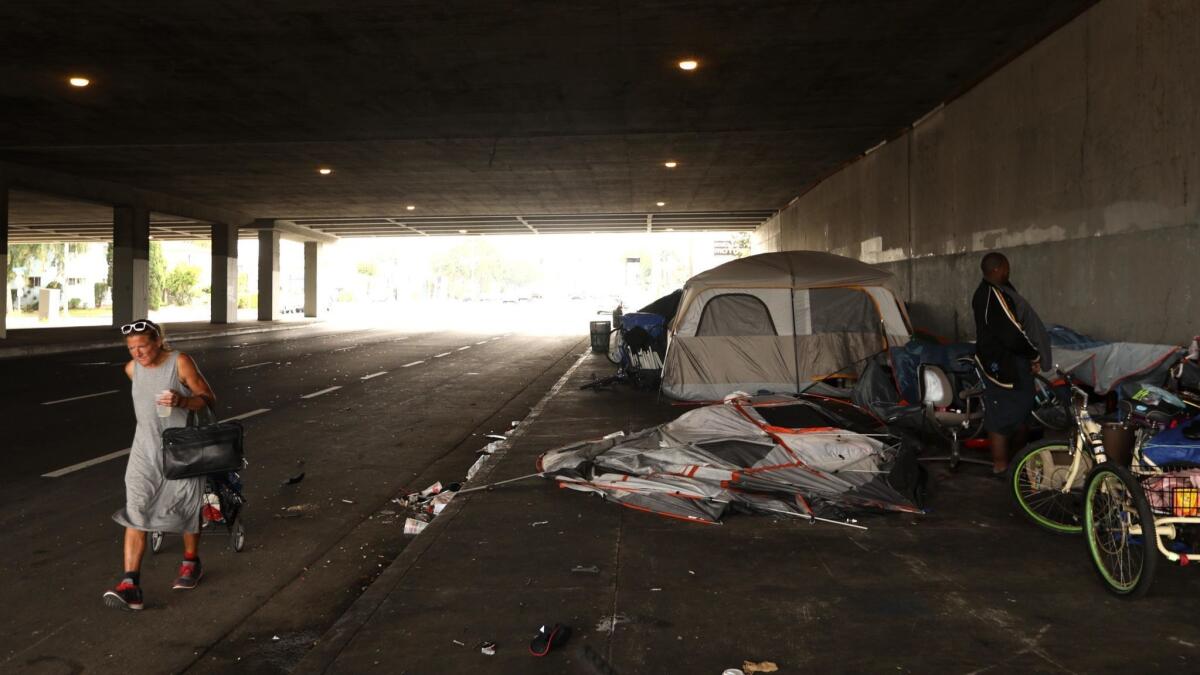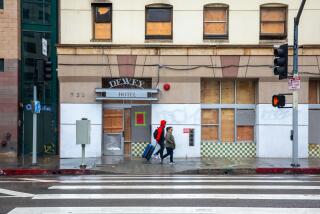Why L.A. County’s homelessness crisis has been decades in the making

Homelessness policy in Los Angeles has been marked by fits and starts over the years — often centered on skid row and downtown, although Hollywood, Venice and the San Fernando Valley have long had their own problems.
On Tuesday, the Los Angeles Homeless Services Authority reported that the number of people living in shelters, in vehicles and on L.A. County’s streets increased by about 12% over last year.
The annual point-in-time count, delivered to the Board of Supervisors, put the number of homeless people just shy of 59,000 countywide. Within the city of Los Angeles, the number soared to more than 36,000, a 16% increase.
People left behind by the economic recovery can’t compete with young professionals who have bid up rents to record levels. In another era, those Angelenos might have found refuge in crumbling hotels and tenements. But many of those buildings were lost in the city’s post-recession spree of building, evictions and renovations.
Homelessness first emerged as a crisis in Los Angeles in the 1980s, when encampments began to appear under downtown freeway overpasses.
The city opened urban campgrounds, and then-Mayor Tom Bradley obtained FEMA trailers for homeless people.
But City Council members balked at putting the trailers in their districts, and abysmal living conditions caused the camps to be shut down.
Skid row sanitation has had a similar boomerang trajectory: In 1992, an activist put out portable toilets in skid row. Bradley had them hauled away.
Bradley’s successor, Mayor Richard Riordan, had two dozen portable toilets installed on skid row. Half were briefly yanked out in 1998, then returned after a protest. In 2006, after they were photographed being used for prostitution, the city had them all carted off for good.
Some advocates trace L.A.’s failed policies to the city’s 1975 “containment” policy on skid row, long the haven of last resort for alcoholics, the unemployable and disabled people.
Faced with widespread displacement of poor people during the redevelopment of Bunker Hill’s Victorian boarding houses, the city rejected slum clearance of skid row. Instead, officials concentrated very-low-income housing and homeless services in the the 50-block district.
But it became a dumping ground for hospitals, prisons and other cities to get rid of people with nowhere else to go.
Homeless people on skid row were expected to enter shelters, graduate to transitional housing and finally earn permanent housing through good behavior, including sobriety. But many people fell off that path and never returned.
The containment policy is now considered a failure.
“It is a contained environment,” said Daniel Flaming of the Economic Roundtable, who has studied homelessness. “Exits from homelessness are scarce.”
When homelessness flared again with the crack epidemic in the 1990s, the city and county sued each other over who was at fault. The county had slashed welfare payments, while the city’s land-use policies had reduced the availability of low-income housing.
The lawsuits were settled by forming the Los Angeles Homeless Services Authority, which theoretically split responsibility evenly between the city and county. Critics said it allowed both to evade accountability.
In the late 1990s and 2000s, downtown Los Angeles began its spectacular turnaround from a dark wasteland to a vibrant residential and entertainment hub. Pressure grew for the city to clean up skid row.
Police Chief William J. Bratton in 2006 unleashed his “broken windows” campaign, issuing thousands of tickets to homeless people for minor offenses like jaywalking and throwing out cigarette butts. The streets cleared, but homeless people were arrested for unpaid tickets and bounced from jail back to skid row.
The county adopted a $100-million homelessness plan to build five regional homeless shelters, but a year later shelved it in the face of protests.
Federal courts repeatedly upheld civil rights challenges to the city’s cracking down on homeless people without providing shelter space.
In 2006, the city settled litigation by signing the Jones agreement, which allowed homeless people to sleep overnight on sidewalks. The agreement set the stage for today’s encampment explosion.
“We are dealing with historical consequences of bad decisions made 10 years ago to guarantee a right to sidewalks instead of a right to shelter,” said Westside Councilman Mike Bonin.
In recent years, Los Angeles has focused on placing homeless people in permanent housing quickly, without preconditions, often with rent vouchers.
But qualifying for housing takes months, and Los Angeles has a severe shortage of apartment units for poor people; 500 homeless veterans have vouchers but no place to cash them in, authorities said.
Now, the city is turning again to stopgap measures while streamlining approvals to speed up construction of permanent housing. Plans are underway for shelter expansions, motel conversions, trailer camps, mobile showers and bathrooms, and parking lots for homeless people to sleep in their cars.
“The city and county need to focus on restrooms and showers to get immediate relief,” said Councilman Marqueece Harris-Dawson, chairman of the homelessness and poverty committee.
Last year, Garcetti opened bathrooms on skid row. He said he would house dozens of homeless people — now camped near a freeway overpass — in trailers on a downtown city lot.
L.A.’s homelessness policy had come full circle.
More to Read
Start your day right
Sign up for Essential California for news, features and recommendations from the L.A. Times and beyond in your inbox six days a week.
You may occasionally receive promotional content from the Los Angeles Times.







